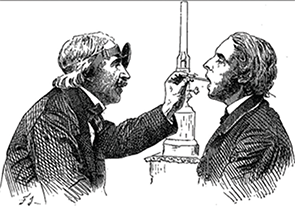
Manuel Garcia using his laryngoscope.
This year marks the 120th year of publication of The Laryngoscope, the official journal of the Triological Society. To celebrate, throughout the year, we’re taking a look back at some of the history of otolaryngology.
Explore This Issue
April 2015Physicians have used tools to examine vocal cords since the mid-1700s. These tools were continuously modified, which allowed for many advances in laryngoscopy and eventually played a pivotal role in anesthesiology.
In 1743, M. Leveret, a French accoucheur, used a bent reflective spatula to assist in the removal of choanal polyps. In 1807, Philipp von Bozzini of Germany developed a speculum to see inside the body that contained two parallel metal tubes, for illumination and visualization, using an external light source (sunlight or candlelight) for the procedure. Later, in 1855, Manuel Garcia also used the sun as an external light source to view the glottis using a tool he developed with two mirrors.
Direct Laryngoscope
Forty years later, in 1895, Alfred Kirstein of Germany developed the autoscope, which consisted of an esophagoscope and an electroscope, to perform the first direct laryngoscopy—which may have been inspired by Kaiser Frederick’s death from laryngeal cancer in 1888. Kirstein later combined a proximal electrical light source within the handle of the autoscope to move the epiglottis and bring the vocal cords into view.
In 1913, Chevalier Jackson, professor of laryngology at Jefferson Medical College in Philadelphia, Pennsylvania, designed a blade with a distal light source. He also incorporated a sliding floor, allowing room for an endotracheal tube or bronchoscope.
The Laryngoscope in Anesthesiology
In the same year, Henry Janeway, an anesthesiologist at Bellevue Hospital in New York City, developed a laryngoscope that allowed anesthesiologists to perform tracheal intubation using a distal light source that contained battery power within the handle. He also added a central notch in the blade and a curve to the distal tip of the blade. While Janeway’s laryngoscope did not gain popularity, he can be credited for making the laryngoscope an instrument fundamental to the field of anesthesiology by allowing for intratracheal anesthesia during surgery, a process that became even more refined by other physicians during World War I.
Since Janeway, continuous modifications have been made to the blade in order to provide better intubating conditions. In 1941, Robert Miller of Pennsylvania designed a blade with a curve on the bottom and a curved distal tip. In 1943, Robert Macintosh designed a blade with a continuous curve to protect the patient’s upper teeth. Since then, more modifications have led to the tools used today, as well as video laryngoscopy.